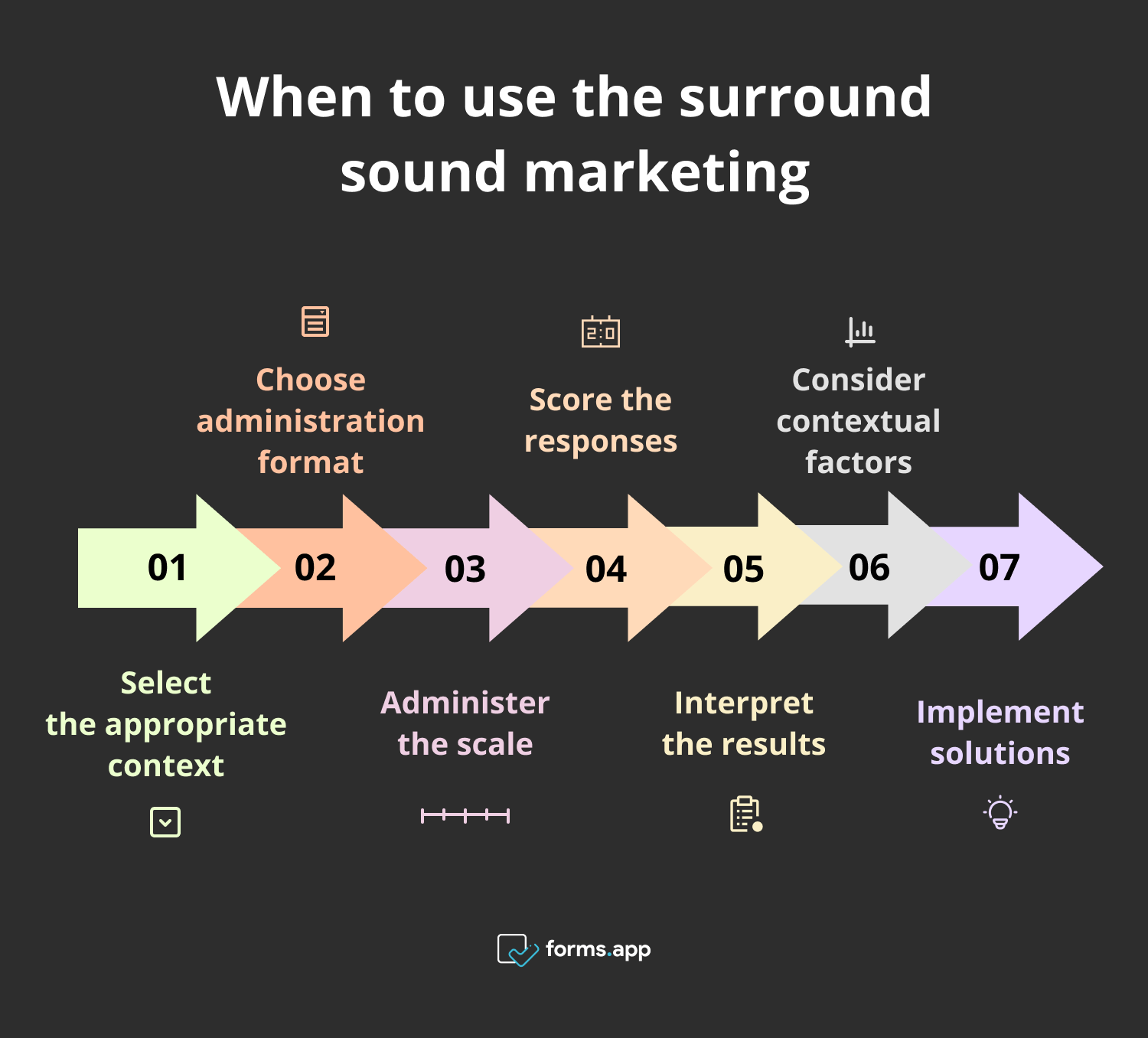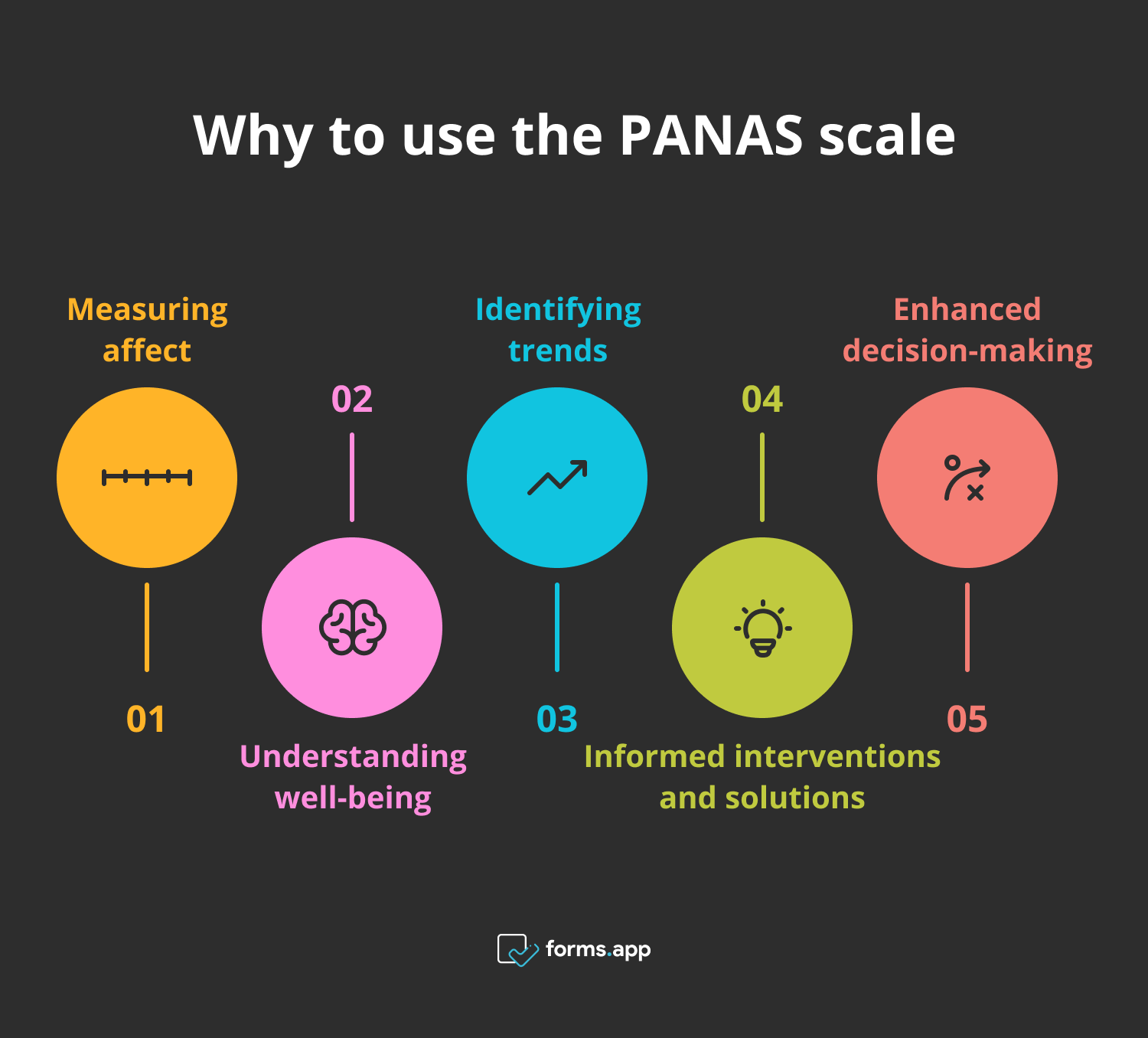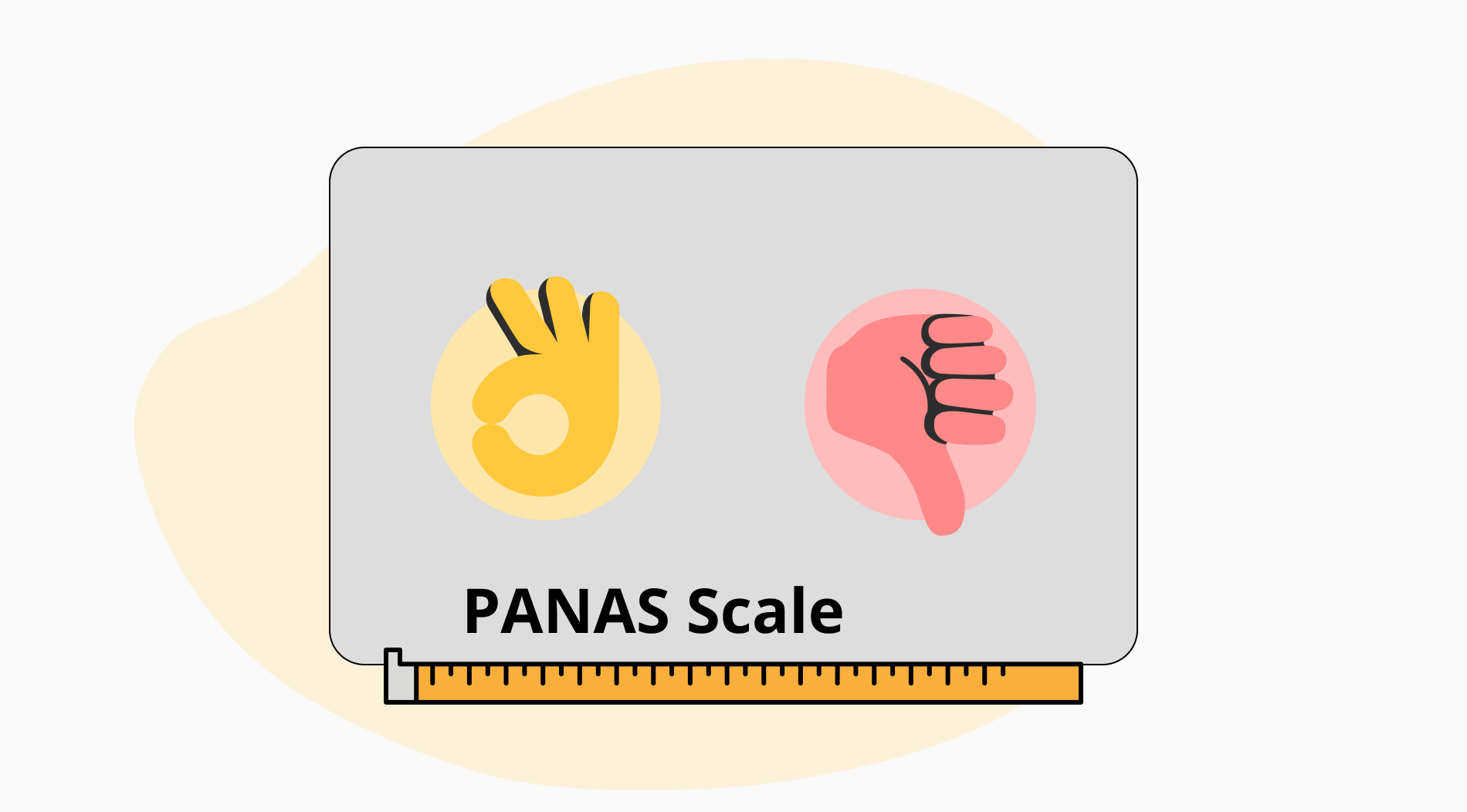Emotions play a fundamental role in our daily lives and influence our thoughts, behaviors, and overall well-being. Understanding and assessing these emotional states are crucial in various fields, from psychology to marketing. Businesses also need to consider emotions while choosing their strategies. Companies can use a psychological scale to take a more systematic approach.
Today, we will delve into one of these tools, the PANAS (Positive and Negative Affect Schedule) scale. It is a widely used psychological tool designed to measure two broad dimensions of emotional experience. We will also discuss its methods, examples, and reasons for using it. You will discover the emotional measurement and its impact on psychology, marketing, and businesses.
First things first: What is the PANAS scale?
The PANAS (Positive and Negative Affect Schedule) is a powerful tool designed to measure the nuances of our positive and negative emotions.
It focuses on two broad dimensions of emotional experience: positive affect and negative affect. The scale was developed by Watson, Clark, and Tellegen in 1988.
The PANAS scale typically consists of two separate sets of items: one set measuring positive affect and the other set measuring negative affect. Respondents rate the extent to which they are currently experiencing each emotion using a Likert-type scale. It ranges from 1 (very slightly or not at all) to (extremely or absolutely).
The PANAS scale: PA and NA
The acronym PANAS stands for Positive and Negative Affect Schedule. The effect refers to positive and negative emotions. The positive effect means emotions such as joy and excitement, while the negative effect includes emotions like sadness, fear, and anger. The scale is specifically designed to measure these dimensions: the PA and the NA, providing insights into individuals’ emotional experiences.
1- Positive affect
Positive affect encompasses a range of positive psychological states, such as joy, happiness, excitement, enthusiasm, and pride. Individuals high in positive affect tend to experience these positive emotions frequently and intensely. Positive affect is associated with various positive outcomes, including better mental health, greater life satisfaction, and enhanced social relationships.
The companies can present their employees with a list of positive emotion words (e.g., interested, excited, proud) and ask them to rate the extent to which they are currently experiencing each emotion in the workplace. The responses are typically recorded on a Likert-type scale, ranging from 1 (not at all) to 5 (extremely).
How do you get the positive affect?
To understand it better, let’s form our positive affect scale. You can ask a question like this to your employees: “How often do you feel enthusiastic or excited about your work?”. Then, you can place the Likert-type scale ranging from 1 to 5 to understand one of the aspects of positive affect in your workplace:
1- Very slightly or not at all
2- A little
3- Moderately
4- Quite
5- Extremely
These types of questions assess the frequency of the employees’ experience and levels of positive affect. Responses to this question can provide insights into employees’ levels of engagement, satisfaction, and overall well-being at work. It also helps employers to identify the areas for improvement and implement strategies to enhance positive affect in the workplace.
2- Negative affect
The negative affect involves a range of negative emotions such as sadness, fear, anxiety, anger, guilt, and shame. Individuals high in negative affect tend to experience these negative emotions more frequently and intensely. They may show traits such as pessimism, irritability, and emotional instability. Negative affect can lead to adverse outcomes, including high levels of stress, depression, and anxiety disorders.
Companies may need to understand the feelings and emotions of their employees to avoid any management, production, or teamwork challenges. Thus, they can ensure the well-being and functioning of their workplaces. The responses from 1 to 5, provided by the employees on the extent of their negative emotions, will give an idea to employers about possible solutions.
How do you get the negative affect?
A useful question in this regard may be, “How often do you feel stressed or anxious about your work?”. This question will contribute towards transparency in the workplace and let the employees express their emotions and thoughts freely. As an employer, you may want to know if the majority of your employees are feeling negative emotions.
Upon analyzing the answers to these types of questions with a Likert-type scale (from 1 to 5), you will be able to understand the frequency of negative emotions such as stress and anxiety in the context of job responsibilities. Responses to this question can provide insights into employees’ levels of job-related stress and emotional well-being.
3- PAN Scale: The Positive and Negative Affect
Together, positive affect and negative affect represent two distinct but related dimensions of emotional experience. These dimensions contribute to individuals’ overall emotional well-being and functioning. The Positive and Negative Affect Scale (PANAS) is a powerful tool for companies because it allows them to measure both affects, gain a comprehensive understanding of their employees’ emotional states, and maintain a better workplace.
Employers/managers can use the PANAS scale to determine employees' positive and negative emotions about the workplace. Based on this, they can suggest solutions to eliminate sources of bad feelings or maintain aspects of job-related responsibilities that lead to positive emotions. The positive and negative affects together can help you implement strategies best suited for your team.
How to use the PANAS scale
There are several steps that businesses can follow to effectively use the PANAS (Positive and Negative Affect Schedule) scale. By following these steps, you can access individuals’ positive and negative affect and gain valuable insights into their emotional experiences and well-being. These steps are as follows:

Steps of the PANAS scale
1- Select the appropriate context
Determine the context in which you will use the PANAS scale. You can use it for research studies, clinical samples, or workplace evaluations. Consider the assessed population, the objectives of your assessment, and any relevant ethical considerations to ensure the appropriateness of the scale for your specific needs.
2- Choose administration format
Identify the most suitable administration format for the PANAS scale based on the workplace considerations and preferences of participants. Options include printed questionnaires, online surveys, or one-on-one interviews. Select a format that ensures ease of administration, data collection, and participant engagement while also maintaining reliability.
3- Administer the scale
Once you have selected the administration format, proceed to administer the PANAS scale to participants according to your standard procedures. You need to provide clear instructions for completing the scale, including explanations of the response options for reporting emotional experiences. Ensure participants understand the purpose of the assessment and feel comfortable expressing their feelings honestly.
4- Score the responses
After collecting responses to the PANAS scale, calculate the scores for positive affect and negative affect separately. You need to understand the ratings to obtain total scores representing the overall levels of positive and negative emotional experiences. Follow the scoring procedures (e.g., Likert-type) to ensure consistency and reliability in scoring across the participants.
5- Interpret the results
Once you have calculated the scores for positive and negative affect, you should interpret the results within the context of your specific workplace. Analyze the patterns and trends in participants’ emotional responses. Interpret findings concerning relevant theoretical frameworks or your previous findings. You will be able to discover the implications for decision-making.
6- Consider contextual factors
Take into account contextual factors that may influence the participants’ emotional experiences. You need to consider demographic variables, cultural differences, situational factors, and individual characteristics. You should recognize the complexity and subjectivity of emotional experiences and be careful before jumping to conclusions according to numerical statistics. Ensure a nuanced understanding of your employees’ well-being.
7- Implement solutions
Finally, apply the insights gained from your PANAS scale assessment to solve any organizational or emotion-related problems in your workplace. Consider how the feelings contribute to advancing knowledge in your business and address the practical challenges. This way, you will be able to promote the well-being of the individuals and groups assessed. Implement valid measures.
Examples of the PANAS scale
Although the PANAS scale (Watson et al. 1988) originated in the field of psychology, it applies to various other fields, including marketing and business management. You will now get a clearer understanding of the Positive and Negative Affect Schedule scale with the help of the hypothetical scenarios of large corporations. Let’s look at some examples:
1- Johnson & Johnson
Let’s think that Johnson & Johnson, a multinational corporation, uses the PANAS scale to assess their employee well-being and affective states across its various departments and locations. Firstly, they conduct regular surveys. These surveys have questions for the participants to rate the intensity of their feelings from 1 to 5.
For positive affect, the company asks questions like: “How much joy do you experience in general” or “To what extent do you feel enthusiastic in your workplace?”. And, for negative affects, their questions include: “To what extent do you feel nervous in the office?” or “Do you feel stressed or upset during your work experience?”
This enables employees to rate their positive and negative affect levels. Johnson & Johnson analyzes the data to identify trends and patterns and implement targeted solutions. Thus, the company improves employee morale, engagement, and overall job satisfaction. This, in turn, leads to increased productivity and enhanced organizational performance for the company.
2- DHL
Imagine that DHL, a global logistics company, implements the PANAS scale to assess employee well-being and job satisfaction within its branches. They conduct anonymous surveys distributed to employees across various locations. These surveys include questions about positive and negative affect. They involve questions such as:
- How enthusiastic do you feel about your work at DHL? (positive affect)
- How proud do you feel to be part of the DHL team? (positive affect)
- How often do you feel stressed while performing your duties? (negative affect)
- How frequently do you feel overwhelmed by the demands of your job? (negative affect)
DHL analyzes the survey responses to identify trends and patterns in employee satisfaction. Based on their findings, the company implements solutions and initiatives. They prioritize employee mental health and job satisfaction. DHL also fosters a positive work environment and enhances employee engagement. It also improves overall organizational performance.
Why use the PANAS scale
We have seen the detailed definition and description of the PANAS scale. We have examined how to use the PANAS scale and which steps to take. You have witnessed how large corporations can use it to enhance their organizational performance. Now, let’s look at the advantages of the PANAS scale and why we should use it. Here are some reasons:

Reasons to use the PANAS scale
1- Measuring affect
The PANAS scale is a reliable tool for measuring both positive and negative affect. It offers a standardized method to assess individuals’ emotional states. Its structured format allows for consistent measurement in different contexts. The scale provides organizations with valuable insights into the emotional experiences of their employees.
2- Understanding well-being
With its ability to measure both positive and negative emotions, the PANAS scale offers a nuanced understanding of individuals’ overall well-being. You can get the spectrum of emotional experiences and gain deeper insights into the psychological health of your workforce. Then, you can plan and implement your solutions.
3- Identifying trends
Regular PANAS scale allows companies to track changes in affective states over a period of time. It makes it easier to identify trends and patterns. This approach enables companies to monitor the effectiveness of their solution and interventions aimed at improving employee well-being. Thus, they can adjust strategies as needed to promote long-term satisfaction.
4- Informed interventions and solutions
The PANAS scale serves as a valuable tool for informing interventions and enhancing employee well-being. After you identify the areas of concern and understand the specific emotional experiences of employees, you can develop targeted interventions, solutions, or initiatives to address the problems. You will be able to create a positive working environment and mitigate the negative affect in your workplace.
5- Enhanced decision-making
Including the assessments of employee well-being in your decision-making enables you to make more informed choices. Your decisions will prioritize employee well-being. By considering emotional states and other relevant factors, you can develop strategies and policies for a positive work environment. You will witness that this type of decision-making will contribute to the overall success and satisfaction of your workforce.
Frequently asked questions about the PANAS Scale
As you can see, there are some valid reasons for using the PANAS Scale in your workplace. You can create a more positive working environment and eliminate any challenge that arises from the negative emotional state of your employees. Now, let’s look at some of the most frequently asked questions about this useful scale:
The PANAS (Positive and Negative Affect Schedule) scale is a widely used psychological tool designed to measure two broad dimensions of emotional experience. The dimensions are the positive affect (PA) and the negative affect (NA). It consists of a series of statements related to specific emotions.
This scale applies to many fields, including marketing and business management. Respondents rate the extent of their emotions on a Likert-type scale. The researcher/employer can analyze the trends and patterns in the responses. Then they can implement informed solutions and initiatives for the individuals’ emotional states and well-being.
The PANAS scale measures two primary dimensions of emotional experience: positive affect and negative affect. Positive affect refers to the extent to which individuals experience positive emotions such as joy, excitement, and pride. The negative affect involves the degree of negative emotions such as sadness, fear, and anger. By assessing these affects, the PANAS scale provides insights into overall well-being.
The PANAS scale has demonstrated reliability and validity across various populations and settings. Numerous studies have reported high consistency for both the positive and negative affect scoring. It has demonstrated the ability to differentiate between positive and negative affect as distinct constructs, further supporting its discriminant reliability and validity (Watson et al., 1988; Crawford and Henry, 2004; Thompson, 2007).
There are several versions of the PANAS scale, including different language versions, shortened versions, and modified versions for specific groups and purposes. Some adaptations focus on cultural differences in emotional expression, while others aim to enhance the scale’s sensitivity. One of the examples is the PANAS-X, involving additional subscales and items for use in non-English-speaking populations.
Despite its widespread use and strengths, the PANAS scale has some limitations. One limitation is its reliance on self-report measures. This may be subject to biases such as social desirability or response distortion. Moreover, the PANAS scale assesses only current emotional states and may not capture longer-term emotional experiences. Cultural differences may also be a challenge when interpreting the responses.
Final words
In conclusion, the PANAS scale is a valuable tool for measuring the positive and negative emotions of the target audience. It may be a psychological scale, but it applies to many fields, including business management and marketing. It has many advantages when used properly and can help employers foster a more positive working environment.
In this article, we have covered the PANAS scale in detail and seen how to use it. We have witnessed its advantages with large corporation scenarios. Last but not least, we have answered the most frequently asked questions about the scale. Start using the PANAS scale in your business now!
forms.app, your free form builder
- Unlimited views
- Unlimited questions
- Unlimited notifications



